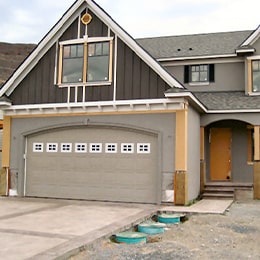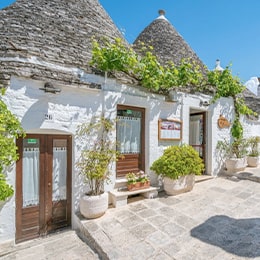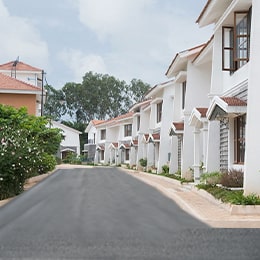Selection of Land
Our culture considers the earth to be ‘Mother earth' and the land has a very close relationship with Vastu. The land has to be carefully selected before constructing a house or a building. One must have the knowledge about the auspicious and inauspicous types of land. We should know which type of land can lead us towards prosperity and happiness and which type of land should be avoided.
For residential purpose one should always select 'live' land. Land bearing healthy plants and trees is considered to be live land. Infertile barren land is called 'dead' land, which is avoidable. Cracked land with termite and bones should not be selected for house construction. According to 'Brihat Samhita' barren land destroys wealth and uneven land invites enemies. Hence just as clean and pure food fills our body and mind with vitality and happiness, similarly auspicious land fills our life with happiness and peace.
Brihat Samhita says:
शस्त्रोषधि द्रुम लता मधुरा सुगन्धा, स्निग्धा समा न सुषिरा च मही नराणाम |
अप्यध्वनि श्रम विनोदमुपागतानाम्, धत्ते श्रियं कियुत शाश्वत मन्दिरेषु ||
The land which has all kinds of medicinal plants, trees, creepers and flowers and which is devoid of pits and gaping holes is superb land and it should be used for constructing a house. People living in such a house acquire name, fame and prosperity. The land which is the abode of a 'Nakul' or a mongoose is excellent for constructing a house. Such a house also is a bestower of name, fame and prosperity. Such land remains free from ghosts and evil spirits. The reason for this is the 'Nakul', who represents Sun. Sun and Rahu (evil spirits) are enemies. Nakul and snake are also enemies, so the snake cannot harm the people living the house. Land with a stable is also very good. House constructed on such a land gives freedom from disease, wealth and property. Horse is also a representative of Sun. Such land is particularly auspicious for people having Aries, Leo and Sagittarius rashis. Hindu religion considers land with a 'Goshala' to be very auspicious for construction of a house, but constructing a house on grazing land for cows is considered to be a great sin. Such a person is always miserable and goes to hell after death. The land having honey bee is wealth producing, and is auspicious, because honey represents Jupiter.
- If horn of a cow or conch or a tortoise is found on the land then such land is auspicious
- If stones are found on digging it indicates gain of gold
- If bricks are found - it shows prosperity
- If money is found - it shows comforts
- If metals like copper are found - it shows luxury and happiness
Consideration Pertaining to Land
Inauspicious Land
Land inhabited by dogs, pigs or jackals or other dirty animals is inauspicious. Constructing a house on such land is not beneficial.
Land inhabited by snakes and scorpions is not suitable for house construction. These creatures represent Rahu. Such land gives all kinds of sudden troubles and misery. The people suffer due to untimely sudden death or sudden accidents or calamities. The family members get addicted to liquor, drugs or cigarettes. They indulge in gambling or other low types of activities. They lose their wealth in this manner.
Land where coal, iron, lead or black articles are found is called 'Asuri Bhoomi'. Living in a house built on such land is inauspicious.Land where coal, iron, lead or black articles are found is called 'Asuri Bhoomi'. Living in a house built on such land is inauspicious.
Examination of the Land
Before buying a new plot of land it is essential to get it checked by vastu experts. Following principles should be followed for the examination of the land.
- Dig 1x1 foot deep pit and fill it with the clay that comes out from it while digging it. If clay increases in quantity then it is excellent land, if the pit gets filled till the level then land is medium and it is inauspicious if the pit remains empty.
- Dig 1½ feet pit in the northern direction of the land and fill it with water completely and walk 100 steps towards North or watch the pit after 120 seconds. If pit remains full of water the land is best, if half consider it medium and if empty it is an inauspicious plot of land.
- Vishwakarmaprakash gives a unique method of land examination. White wash the pit and light four lamps made of clay in all four directions by pouring ghee in it and see lamp of which direction gives the maximum light. If the lamp of North gives maximum light then that land is Brahmin, if the lamp of East gives more powerful light it is Kshatriya land, more prominent light of West denotes Vaishya land and that of South denotes Shudra land.
- Plough the land on which you plan to construct a house and sow all types of grains in that. If the seeds of these grains give sprout within three days it is the best land, if sprouts come after 5 days it is medium, however it should be considered inauspicious land if sprout comes after 7 days. If seeds of different types are not available in that case the seeds of paddy can be shown. House should not be constructed in that part of the land where these paddy seeds do not grow.
- There are 7 aushadhees (medicine) i.e, Vreehi, green lentil, wheat, mustard, saathi, sesame, and barley. These are known as all seeds. After sowing these seeds you must see their results. The land where there are flowers of copper and gold colour is considered to be very auspicious.
- Sometimes a piece of land is not examined before starting the construction work but this is wrong because it can result in disaster. For example if there are hairs, bones, dirty clothes, egg shells, termite and eggs of boa in the land then the house constructed in that place always brings sorrows. Burnt coal brings disease; begging bowl and iron are the symbols of death. Bones, skull, hairs etc, decrease the life span of the owner of the house.
Types of Land
According to ancient books on Vastushastra, the land has been classified into four categories:
Brahmin Land
The land which is white in colour and smells like Ghee, whose taste is sweet like nectar and the touch makes us feel good, is known as Brahmin land. On this type of land there are trees of Kusha and Durva which are used for Homa. This type of land brings spiritual bliss and comforts of all types. This type of land is used for the construction of schools, temples, guest houses and literary institutes.
Kshatriya Land
The land which is red in colour and smells like blood, whose taste is astringent and the feel of touch is solid, is known as Kshatriya land. Snakes also live on this land. This land enhances kingdom, power and influence. This type of land is useful for the construction of government offices, cantonments, colonies of soldiers and arsenals.
Vaishya Land
The land which is green-yellow in colour and smells like nectar or like grain and tastes acidic, is known as Vaishya land. Grains and fruit trees are grown on this type of land. Vaishya land enhances money and wealth. This type of land can be used for constructing professional buildings, shops and houses of businessmen.
Shudra Land
The land which is black in colour and smells like wine and tastes bitter is known as Shudra land. There are useless bushes and shrubs on this type of land. This type of land creates quarrels and feuds, therefore this land is not advisable for the construction of a residential building.
In this way, the classification of land has been done on the basis of colour, taste and smell and according to this the kshatriya land is suitable for military cantonment and arsenals. Vaishya land is suitable for corporate houses and business persons whereas Brahmin land can be used for constructing schools and temples. But in modern times the construction of buildings is not possible on the basis of this classification. For instance the soil of Karnataka is red, that of Gujarat and Maharashtra is black, whereas the soil of Dwarkapuri is white. In that way would it be appropriate to construct schools, temples and literary institutes in Karnataka? Therefore this fact appears to be far from reality. In modern times such a land can be chosen for construction, which is fertile, with lot of availability of water and with solid soil on which the building shall remain stable and strong.
Examination on the Basis of Surface of Land
The central harder part of the land is known as surface. The classification of land on the basis of type of surface is as follows:

Gajaprishtha
The land which is elevated in South, Southwest, West and Northwest is known as Gajaprishtha. The house constructed on Gajaprishtha land, is considered to be very auspicious for the blessings of goddess Laxmi and it is believed that wealth and longevity go on increasing in that house.
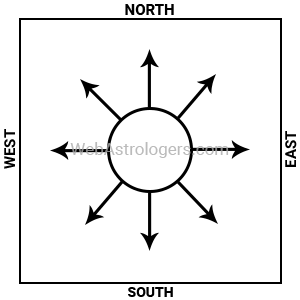
Koormaprishtha
The land which is elevated in the centre and low in all four directions is known as Koormaprishtha. This type of land is auspicious for residence. Living in this type of land, one's enthusiasm enhances regularly and one attains happiness, wealth and prosperity.

Daityaprishtha
The land which is elevated in the Ishan, East and Agneya and is low in the West is called daityaprishtha. The blessings of goddess of wealth (Laxmi) do not come into the house constructed on Daityaprishtha and there is continuous loss of wealth and sons in that house.
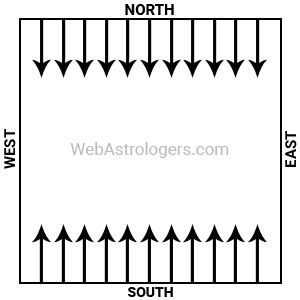
Nagprishtha
The land which is long in East and West and elevated in South and North is known as Nagprishtha. By living in nagaprishtha land the members of the family start suffering from mental diseases and there is an increase in the number of enemies for the owner of the house. The house constructed on this land brings losses to the wife and children.
Slope of the Land
While examining the land we should also notice the direction in which the land is sloping and the direction which is higher.
Slope towards the East
If the slope of the land is towards the east, then the residents of a house built on this land gain wealth. This land is considered auspicious for progress and growth.
Slope towards the North
Slope of the land towards the North enhances prosperity and good fortune. It also assists in propagating the family lineage. (Vansha Vriddhi)
Slope towards the West
Slope towards the West destroys wealth and wisdom. It also creates regular disputes in the family.
Slope towards the South
Slope towards the South is disease producing and it can cause untimely death.
Slope towards the Northeast
Slope towards the Northeast bestows all round success, enhancement of fortune along with name, fame and prosperity.
Slope towards the Northwest
If the slope is lower than the Northeast, then the residents have many enemies and have regular thefts in the house. The owner is always attacked or is involved in court cases. Health of the family members remains a cause for concern.
Slope towards the Southeast
If this is lower than the Northeast, then there is danger of fire and enemies. This is especially bad for the women and children. It also creates thefts, deceipts, disputes and court cases.
Slope towards the Southwest
Southwest is Rahu's direction. Slope in this direction naturally makes Rahu's hold on the family stronger. With the result their unconventional behaviour increases and they get into bad habits like liquor, drugs, cigarettes, loose behaviour, gambling, crime etc. Their enemies go on multiplying and evil spirits affect their house. They face sudden mishaps and even death.
Conclusion
It can be said that the Nairritya region of the land should be the highest and the Northeast should be the lowest. The Vayavya (N.W.) should be higher than the Ishan (NE) and the Agneya (SE) should be higher than the Vayavya. People residing in such a house achieve all round success, prosperity and happiness.













